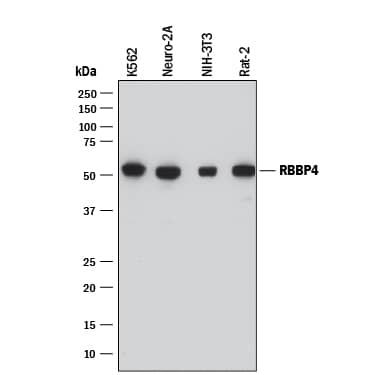Human/Mouse/Rat RBBP4 Antibody
R&D Systems, part of Bio-Techne | Catalog # MAB7416

Key Product Details
Species Reactivity
Validated:
Cited:
Applications
Validated:
Cited:
Label
Antibody Source
Product Specifications
Immunogen
Ala2-Ser425
Accession # 09028
Specificity
Clonality
Host
Isotype
Scientific Data Images for Human/Mouse/Rat RBBP4 Antibody
Detection of Human, Mouse, and Rat RBBP4 by Western Blot.
Western blot shows lysates of K562 human chronic myelogenous leukemia cell line, Neuro-2A mouse neuroblastoma cell line, NIH-3T3 mouse embryonic fibroblast cell line, and Rat-2 rat embryonic fibroblast cell line. PVDF membrane was probed with 0.5 µg/mL of Mouse Anti-Human/Mouse/Rat RBBP4 Monoclonal Antibody (Catalog # MAB7416) followed by HRP-conjugated Anti-Mouse IgG Secondary Antibody (Catalog # HAF018). A specific band was detected for RBBP4 at approximately 52 kDa (as indicated). This experiment was conducted under reducing conditions and using Immunoblot Buffer Group 1.RBBP4 in Human Breast Cancer Tissue.
Retinoblastoma Binding Protein 4 (RBBP4) was detected in immersion fixed paraffin-embedded sections of human breast cancer tissue using Mouse Anti-Human/Mouse/Rat RBBP4 Monoclonal Antibody (Catalog # MAB7416) at 5 µg/mL for 1 hour at room temperature followed by incubation with the Anti-Mouse IgG VisUCyte™ HRP Polymer Antibody (Catalog # VC001). Tissue was stained using DAB (brown) and counterstained with hematoxylin (blue). Specific staining was localized to nuclei. View our protocol for IHC Staining with VisUCyte HRP Polymer Detection Reagents.Applications for Human/Mouse/Rat RBBP4 Antibody
Immunohistochemistry
Sample: Immersion fixed paraffin-embedded sections of human breast cancer tissue
Western Blot
Sample: K562 human chronic myelogenous leukemia cell line, Neuro‑2A mouse neuroblastoma cell line, NIH‑3T3 mouse embryonic fibroblast cell line, and Rat‑2 rat embryonic fibroblast cell line
Formulation, Preparation, and Storage
Purification
Reconstitution
Formulation
Shipping
Stability & Storage
- 12 months from date of receipt, -20 to -70 °C as supplied.
- 1 month, 2 to 8 °C under sterile conditions after reconstitution.
- 6 months, -20 to -70 °C under sterile conditions after reconstitution.
Background: RBBP4
RBBP4 (Retinoblastoma-Binding Protein 4; also RbAp48 and CAF-1) is a 48-56 kDa member of the WD Repeat RBAP46/48/MSI1 family of proteins. It is ubiquitously expressed, and acts as a transcriptional repressor. At the start of G1 of the cell cycle, Rb (retinoblastoma protein) normally associates with an E2F transcription complex on E2F responsive genes, blocking E2F activity. At the appropriate time, Rb is phosphorylated, causing its dissociation from E2F and resulting in E2F activation. Dephosphorylated Rb apparently mediates transcriptional repression by recruiting a histone deacetylase (HDAC), followed by HDAC binding to RBBP4. RBBP4, being a histone-binding protein, now brings histones plus HDACs together, resulting in histone deacetylation and gene silencing. Human RBBP4 is 425 amino acids (aa) in length. It contains six WD repeats (aa 122-403), two N-terminal acetylation sites, and two serine phosphorylation sites at positions 110 and 146. There are at least two isoform variants. One contains a six aa substitution for aa 405-425, while another utilizes an alternative start site at Met36. Human and mouse RBBP4 are identical in aa sequence.
Long Name
Alternate Names
Gene Symbol
UniProt
Additional RBBP4 Products
Product Documents for Human/Mouse/Rat RBBP4 Antibody
Product Specific Notices for Human/Mouse/Rat RBBP4 Antibody
For research use only

